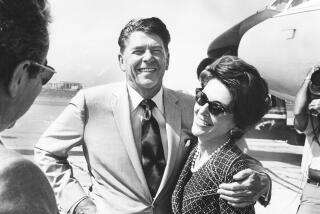Effort to Rebuild State a Tougher Sell in New Era
The year was 1962. Growth was good, the future unlimited. California’s governor was so eager to see the state eclipse New York as America’s population leader that, before it even happened, Pat Brown declared four days of grand celebration.
New Yorkers sniffed at the Western upstart, but Brown’s proclamation touted the achievements that put California at the forefront “in many areas, including education, water development, highways, science and agriculture.”
For the record:
12:00 a.m. Feb. 9, 2006 For The Record
Los Angeles Times Thursday February 09, 2006 Home Edition Main News Part A Page 2 National Desk 1 inches; 45 words Type of Material: Correction
Reagan governorship -- An article in the Jan. 30 California section about Gov. Arnold Schwarzenegger’s public works proposal said that Ronald Reagan took office as California governor on Jan. 5, 1967. Reagan’s inauguration ceremony was on Jan. 5, but he was sworn in Jan. 2.
Today, the Golden State is the same in name only.
Serving at a time of bursting pride and civic promise, Brown oversaw the creation of California’s backbone -- the great institutions and public works that undergirded a prosperity he could scarcely have imagined.
But 40 years later, that foundation is crumbling, and Gov. Arnold Schwarzenegger has called for a building binge unlike any since that heady era.
The challenges he faces are daunting. Money is considerably tighter. The Legislature has already begun to pick apart Schwarzenegger’s $222-billion renewal proposal. Californians have a darker view of growth and a more cynical take on their elected leaders. Gone are the days when a politician would crow, as Brown did, “I’m a big-government man.”
Even Schwarzenegger’s vision reflects his more straitened circumstances.
Whereas Brown was able to tout “the world’s biggest pump and the longest aqueduct,” policy analyst Elisa Barbour said, Schwarzenegger is left to “stand up and say, ‘I’m going to push collaborative planning among multiple stakeholders to promote more efficient use of existing resources.’ ”
Important? Sure. Sexy? Hardly. But that’s the difference between adolescence and middle age, between creation and maintenance, between the boosterism of California’s first 100 or so years and the sobering demands of its next century.
So, as Schwarzenegger stakes his political hopes on the promise of a second golden age, the question is whether California today has the wherewithal, the public will and the hefty wallet that enabled the first.
*
Schwarzenegger is hardly the first governor to preside over explosive growth. The state’s population has increased each year since at least 1900. From the Gold Rush era to the dot-com boom, California has been a magnet for the world, and the population has perennially outstripped the government’s ability to meet the needs of its people.
“The state is always off balance, stretching itself precariously, improvising, seeking to run the rapids of periodic tidal waves of migration,” wrote historian Carey McWilliams, an observation he could have made just last week.
It was published in 1949.
Today, there are more than 36 million Californians, and the number is expected to reach 58 million by 2040.
For all of the contortions McWilliams described, the growth of California’s early years spurred great public investment. In California’s first decade of statehood, the Gold Rush more than quadrupled the population; Congress responded by passing the Pacific Railway Act of 1862, which connected California to the population centers of the East.
The Central Valley Project, a crucial water system, was first envisioned in 1919, when California had 3.3 million residents. By the time construction began in 1935, the population had almost doubled. When the state ran out of money during the Depression, the federal Bureau of Reclamation stepped in.
The thinking, said historian Kevin Starr, was simple: “If we don’t get water, we won’t be able to metropolitanize.”
California had 8.5 million residents when Earl Warren became governor in 1943. After a year in office, he convened a special commission to plan for life in post-war California. A good thing, because by the time Warren left office 10 years later, the population had swelled to more than 12 million.
*
Although Brown is widely celebrated as the state’s great builder, historians and policy experts suggest that view slights the contributions of Warren and Gov. Goodwin Knight, Brown’s immediate predecessor.
Together, the three men remade California’s landscape. During the 1950s and ‘60s, the state more than doubled its capacity to store water. Plans for more than 12,000 miles of freeway were completed in 1959, and “almost three-quarters of the state’s highways were built in the next 15 years,” according to the Public Policy Institute of California, a nonpartisan research center.
It is Brown who is widely celebrated, said the institute’s Fred Silva, because “he forged compromises that translated pending proposals into adopted programs.” But he also stretched the visions of Warren and Knight.
The Master Plan for Higher Education, hammered out under Brown, expanded and organized California’s college and university system. It resulted in construction of three new UC campuses -- Irvine, Santa Cruz and San Diego -- and dramatic growth at outposts in Riverside and Davis. It would be 40 years before California opened another UC campus, in Merced.
“Pat was able to do things because, if there was a fundamental, core belief he had, it was that government should and could do good things, and that a well-funded, vibrant public sector contributed to the long-term benefit of the state,” said Ethan Rarick, a Brown biographer.
Not incidentally, most Californians agreed.
The years under Brown were a time of great optimism and a bit of blissful ignorance. Former Gov. George Deukmejian, who was elected to the Assembly halfway through Brown’s tenure, said Californians embraced growth then because they “didn’t fully realize or appreciate what it was going to lead to.”
Brown took office in 1959 and served through 1966. A Field Poll, the first asking how Californians felt about their home state, was taken a year after he left office. Even after the 1965 Watts riot and growing campus unrest, 73% of those surveyed described California as “one of the best places to live.” The last time the question was asked, in 2003, fewer than half gave that response.
Mervin Field, who has spent more than half a century researching public opinion, said that earlier, upbeat spirit extended to positive feelings about California’s elected officials. “If a leader like Pat Brown came and said, ‘We need this,’ obviously there were people who were critical of him, but a majority believed it,” Field said.
When Schwarzenegger announced his refurbishment plan, the immediate focus was on his political motives.
“For 40 years, the modern conservative movement has demonized government,” said Rarick. As a result, he suggested, it is much more difficult to rally public support and secure funding for the governor’s grand plans.
Proposition 13, the big bang that set off a nationwide taxpayer revolt in 1978, drastically slashed revenue to Sacramento. Between 1945 and 1970, the state spent between $100 and $160 per capita on construction and the like, according to David E. Dowall, a UC Berkeley urban planning professor. By the late 1990s that figure averaged $30.
Under Brown, “there was an understanding that you couldn’t have world-class government services and infrastructure without paying for it,” said Tim Hodson of Cal State Sacramento. Today, “there is a significant body of opinion that is adamantly opposed to any increase in taxes no matter what the purpose.”
California is also less likely to get much financial help from Washington.
“Deficits were small or nonexistent” in the 1950s and 1960s, and aid to state and local governments “was almost in its heyday,” said Stanley E. Collender, an expert on the federal budget. Now, “Unless there’s a natural disaster ... the chances of funding a major infrastructure project from Washington is very, very small.”
The political culture has changed as well.
Although a certain amount of retrospective rosiness is applied to the Brown years, old hands say there is some truth to memories of Sacramento as a less partisan place. That more cooperative spirit -- combined with more generous budgets -- also helped get things done.
It was a time before term limits, for better or worse. Although reformers point to the era’s backroom dealings, members also had a chance to hone their policy expertise and forge the personal relationships that lubricate the legislative process.
Bill Bagley, a moderate Marin County Republican first elected to the Assembly in 1960, said, “When you play cards damn near all night with people,” you don’t cheat them the next day on the floor.
*
The Brown era came to an abrupt end on Jan. 5, 1967, when Ronald Reagan -- a sworn enemy of big government -- took office. By then, California’s population had swelled to almost 19.2 million people.
At the same time, the environmental movement had begun to blossom, changing public attitudes that more was always the best answer to growth.
Although the population continued its relentless rise -- hitting nearly 24 million by 1980 -- cities throughout the state began passing growth limits. Land and building costs jumped, adding a further hurdle to large-scale public projects.
Although California voters approved nearly $83 billion in government bonds between 1972 and 2004, more than half of the construction money went to education projects. Successive governors put off maintenance on everything from roads to levees, leaving an infrastructure bill that Schwarzenegger pegs at more than $500 billion over the next 20 years.
Now he faces a formidable job selling his vision to the Legislature and California voters. Political observers suggest that the task will require more than photo opportunities on freeway offramps, particularly after the bruising that Schwarzenegger took in November’s special election.
“He’s got to be very substantive and very serious and do away with all of the Hollywood PR,” said Tony Quinn, an independent analyst in Sacramento.
A recent opinion poll offered mixed messages.
About six in 10 Californians said they wanted the state to spend more money on infrastructure, according to the Public Policy Institute survey. But when asked to name the issue that is most important for the governor and Legislature to work on this year, only 3% named roads and infrastructure.
Needing a two-thirds vote in the Legislature to get the bonds on the ballot, Schwarzenegger either will have to scale back his proposal or rally at least a handful of Republicans around the idea of more debt and higher taxes, which proponents in the GOP would rather call “fees.”
Democrats, meantime, are loath to hand Schwarzenegger any sort of election-year victory. But with enough public pressure, Quinn suggested, Schwarzenegger might be able to bring them around. It wouldn’t hurt, he said, to summon their inner Pat Brown.
“This is their chance as legislators to really do something big,” Quinn said. “He can appeal to the fact they’re gone in two years, four years, and do they want to leave the same kind of mess they found? Or do they want to be a part of what could be another golden age?”
More to Read
Get the L.A. Times Politics newsletter
Deeply reported insights into legislation, politics and policy from Sacramento, Washington and beyond. In your inbox three times per week.
You may occasionally receive promotional content from the Los Angeles Times.












